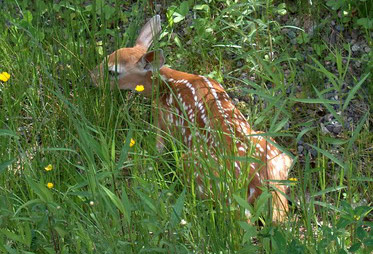
Kidnapping Deer Fawns Discouraged
 During late May and June, it is common for people to find deer fawns they mistakenly believe to have been orphaned or abandoned by their mothers. Understandably, most people have empathy for these animals and want to take them home to nurture, with the intent of releasing them back into the wild at a later date. Though we may feel this is the humane thing to do, these attempts to "save" fawn deer are generally unnecessary and most frequently result in premature death of the fawn.
During late May and June, it is common for people to find deer fawns they mistakenly believe to have been orphaned or abandoned by their mothers. Understandably, most people have empathy for these animals and want to take them home to nurture, with the intent of releasing them back into the wild at a later date. Though we may feel this is the humane thing to do, these attempts to "save" fawn deer are generally unnecessary and most frequently result in premature death of the fawn.
Doe deer usually leave their fawns in hiding areas while they forage for food. This is not abandonment. The doe will return 3 or 4 times a day to check on her fawn and allow it to nurse.
Deer live well in close proximity to people and a surprising number of deer live within or near our communities. As a result, people often find deer fawns in tall grass or areas of shrubs and brush, in wooded areas within towns, near industrial sites and subdivisions or on agricultural land. If you find a fawn, regardless of the location, simply leave the animal alone.
Film and television programs glamourize keeping wild animals as pets, but the reality is far less pleasant. By bringing a wild animal home you are effectively kidnapping it from the environment to which it is best adapted and condemning it to an unnatural and often short life. Deer are a wildlife species that can not easily be tamed. It is a herd animal with natural instincts honed for survival and self-preservation in a forest habitat.
If hand reared, a deer fawn will quickly imprint on humans. When this happens it begins to think of itself as being more human than a wild deer. It will lose its natural fear of humans as well as our pets and vehicles. As they get older, these pet deer (especially bucks) become extremely dangerous. A hand raised deer will never have the skills to survive in the wild on its own. It will be more likely to remain near humans, be hit by a vehicle, cause property damage and have the ability and inclination to be aggressive with an eye to humans which has often resulted in serious injury and death. This is why keeping a deer fawn is illegal across most of North America. In Nova Scotia only licensed and specially constructed wildlife rehabilitation facilities may be certified to take care of orphan deer fawns. Because of disease issues (including Chronic Wasting Disease) the Provincial Wildlife Park at Shubenacadie and the Two Rivers Wildlife Park in Cape Breton are no longer permitted to take in orphaned, injured or sick deer.
If you have already brought a fawn home, please contact your local Department of Natural Resources and Renewables office as soon as possible. If it has been less than 48 hours since you removed it from the wild, you will be instructed to immediately return it to the location where it was found. During this time the doe may still reunite with its fawn and continue to care for it. The longer the fawn has been away from its mother, the less likely it is to reunite with its mother and survive.
However, if it has been more than 48 hours since the animal was removed from the wild, it must be brought in to your local Department of Natural Resources and Renewables office.
Most humans have a basic need to nurture and care for young animals they encounter. However, when wildlife are involved the result is most often tragic for the animal. If we truly care for wildlife... let them remain wild.